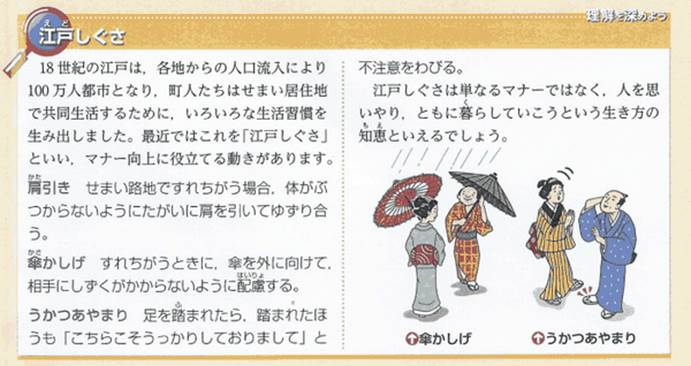|
27.6.10 NEEC 赤字はFredによる修正 江戸しぐさ (コメント) 学校の道徳教範にも取り上げられている、公共のマナーを教える「江戸しぐさ」に関するものです。この江戸しぐさが、史実を無視した全くの作り話であると言う本が出版され物議をかもしている記事が、昨年5月6日付のジャパンタイムズ紙に掲載され それが英語教室のTextになりました。私はその本の著者の方に偏見がある旨スピーチしました。 |
||
|
1.原田実氏が著した江戸しぐさを否定する本「江戸しぐさの正体―教育をむしばむ偽りの伝統」(星海社新書)についてであるが、どうも否定する側の筆者の論理も怪しい。むしろ原田氏の批判の方が現実にそぐわないのではないかと私は感じる。 |
As for the book which denies Edo-style etiquette written by Minoru Harada, his logic for the denial is also somehow dubious. I feel that Harada's criticism rather does not match reality.
|
|
|
・例えば、原田氏はいくつかある江戸しぐさの中から、「肩引き」、「かさかしげ」、「こぶし腰浮かせ」の3つについて否定した後は、江戸しぐさを今に伝えた芝三光と弟子の越川禮子の人物批判ばかりしている。また、しぐさの否定についても「肩引きは威嚇にしか見えない」など本人の主観を述べているに過ぎず、論理的な説明になっていない。(原田実氏の批判 参考2参照) |
For example, after Harada denied three etiquettes such as “kata hiki”, “kasa kashige”, and “kobushi ukase” out of eight examples of Edo-era etiquette, his heavy criticism is concentrated only on Mitsuakira Shiba’s and his apprentice, Reiko Koshikawa’s, personal career. Also, as for the denial of three etiquettes, for instance, he says that “kata hiki” looked like only intimidating the others. This criticism is entirely subjective and, therefore, quite illogical. Incidentally, “kata hiki” is the “shigusa” to pull one side of shoulders back when two people pass each other on the narrow lane not so as to collide. |
|
|
・また、「江戸しぐさ」が歴史的考証に耐えられない内容にもかかわらず、何故これまで専門家から批判が出てこなかったのかと言う質問に対し、原田氏は、専門家から見れば、あまりにばかばかしいので、いちいち反論しようという気もおきなかったのだろうと答えている。しかし、専門家が見向きもしないものを文科省が推奨し、多くの学校が採用するであろうか?原田氏の言う専門家とはどのような連中なのか? |
Why didn't experts criticize Edo-style etiquette so far even though they can't stand up to historical scrutiny? For this question, Harada says, “Since it is so absurd from expert’s point of view, they didn’t feel like making a counterargument.” However, will Ministry of Education, Culture, Sports, Science and Technology (MEXT) recommend and many schools adopt such thing which experts entirely ignore? What experts does Harada mention about? |
|
|
・原田氏の言う「わずか数人によって生み出された偽の歴史」が、何故これほどまで広まり、国や自治体などの行政が推薦するようになったのか? 原田氏は、その問いに対し、基本的に人々は“いい話”を疑わない、1970~80年代には「江戸ブーム」が盛り上がっていて、“江戸時代のいいもの”なら受け入れるような社会的な土台が出来ていたと言う。 他方、記事にある茨城県守谷市教育委員会が江戸しぐさを参考にして「守谷しぐさ」を作成したのは先月であり、原田氏が江戸しぐさを虚偽とする本を出版した昨年8月以降である。守谷市教育委員会が原田氏の本を知らない筈はなく、むしろ原田氏の本の方を胡散臭いと感じ、虚偽とする氏の言い分を無視したのではないか。
|
Why has the history fabricated by several people circulated that much? Why have the central and local governments recommended Edo shigusa? For these questions,
Harada responded, “People do not suspect "the good thing" basically.
The "Edo boom" was rising in the 1970s-80s. And the background which
accepts every good thing However, it was last month that the board of education in the city of Moriya, Ibaraki Prefecture, launched a pilot project to teach Moriya shigusa, which is inspired by Edo shigusa. And yet it was after last August when Harada wrote this book. It is impossible that the board of education in the city of Moriya can be ignorant of Harada's book. Therefore, the city of Moriya might think Harada's book was rather dubious than the NPO group Edo Shigusa. |
|
|
・教科書にまで浸透している現状を考えると、批判するだけで「江戸しぐさ」の拡大を防ぐのは難しいのではないかとの問いに対し、原田氏、次のように答えている。 最早「江戸しぐさ」が根絶されることはない。しかし、少なくとも教育現場で安易に使用されるべきものではない。一番の問題点は、教育現場で用いてしまうと、虚偽を根拠にして道徳を説くことになってしまうということである。それは、道徳の根幹である信頼を否定する行為である。「江戸しぐさ」が虚偽であることを承知した上で使うことなど論外である。そう言いつつ彼は、「イソップ寓話」のようなフィクションを道徳教育で用いること自体は問題ない、しかし、「江戸しぐさ」の場合、それがフィクションであるとわかった途端に、有難さが失われてしまうと言う。何故なら、江戸しぐさは、芝三光という老人が江戸時代以来先祖から受け継いで来たと言うことで、有難がられてしまったからだと言う。イソップ寓話も作者や起源などよくわかっていないのに、西洋のフィクションは是であり、江戸しぐさは捏造であるため否とする見方は如何なものか?
|
Isn't it difficult to prevent further expansion of Edo shigusa only by criticizing, considering the present situation so that it has permeated into the school textbook? Harada answered “Edo shigusa While saying so, he
mentioned, “It was satisfactory to use fiction |
|
|
・「結果的によいマナーが浸透すればいいではないか」という意見に対し、原田氏は、そうすると形だけのマナーのために倫理の根幹を破壊することになると言う。しかし、江戸しぐさは、国民に良いマナーを教えるのに有効と考えられたからこそ教育現場で採用されたのであり、作られた経緯が倫理的であるか否かで選択されたものではない。守谷市もそのように判断したからこそ江戸しぐさを参考にしたのであろう。
|
For the given opinion "Good manners had better permeate people as a result, even though it is fabricated,” Harada says, “Doing so will come to destroy the ethical basis for the sake of manners that remain only in form. However, the biggest reason why Edo shigusa was selected in the field of education is attributed to its content which is effective for teaching good manners to people. It was not chosen by how it came about. That is why the city of Moriya judged so and has created a booklet, learning from Edo shigusa. |
|
|
2.原田氏のインタビュー記事を読みながら私が感じたのは、我が国の道徳教育に反対する勢力の存在である。原田氏の本を真っ先に大々的に取り上げたのは、あの左派系の東京新聞である。東京新聞は今年4月6日付の“こちら特報部”と言うコラムで、「江戸しぐさに史料の裏付けなし」と言う見出しで原田氏の本を詳しく取り上げている。そして、伝統を隠れみのにした国や自治体がもてはやす道徳教育は科学の軽視であり危ういと結論付けている。朝日、毎日、東京新聞などの左派系メディアがいきり立って反対するのは、道徳教育の復活である。これらメディアに共通するのは、「価値観の押し付けはやめよ」という主張である。 一例として、昨年10月22日付けの朝日新聞は次のように述べている。 「道徳」が小中学校で子どもたちの学ぶ教科になる。中央教育審議会が昨日、その答申を文部科学相に出した。これまでは教科外の扱いだったが、早ければ2018年度にも格上げされる。戦前の「修身」が軍国主義教育を担ったとして終戦の年に廃止されて以来、70年目の大きな転換となる。教科にすることで多様な価値観が育つのか。かえって逆効果になりはしないか。その懸念をぬぐえない。
しかしながら、日本には戦前の道徳教育があったからこそ、今も世界から「道徳心が高い」、「民度が高い」国として評価されるのだ。東日本大震災が日本を襲った際、略奪も犯罪も起きず、支給された食糧を「もっと困っている人に」と譲る精神・行動に世界から称賛が寄せられた。学校や家庭での躾、教育、道徳教育がなくなれば、こういう日本人らしさは時を経て失われていくだろう。そうなってからでは遅いのである。江戸しぐさを行政側が教えることは必要なのである。教育現場から駆逐されなければならないのは、左翼メディア、進歩的文化人、日教組などの“歪んだ価値観”であろう。 |
Reading Harada's
interview, I suspect the reformist-factions which have opposed to the moral
education in our country are behind him. Tokyo Shimbun was the first paper to
highly publicize Ethics will become a formal subject for Japanese children at elementary and junior high schools. The Central Council for Education, an advisory panel for the education ministry, on Oct. 21 submitted to education minister, Hakubun Shimomura, its proposal that ethics should be taught as a subject. Ethics has been treated as a “non-subject” activity. But it will be given the status as a formal subject as early as the academic year that starts in April 2018. This will represent the first major change in Japan’s ethics education in 70 years since the prewar “shushin” (morals) classes were abolished in 1945, the year when World War II ended, on grounds that they supported the nation’s militarist education system before and during the war. Will making ethics a formal subject really help nurture diverse values? It is hard not to worry that the step will have the opposite effect. However, thanks to once existed the pre-war “shushin” (morals) classes, Japan is still regarded as a nation which has a keen sense of morals and is at a high level of culture from all over the world. The tragedy in March 2011 was one of the greatest natural disasters that occurred in modern society. However, even in the midst of their crushing adversity, people have not resorted to mass looting, rioting, thievery, or hysterical panic. On the contrary, people have shown virtues such as calmness, politeness, affection for the weak, self-sacrifice, and yet order remains intact. The Japanese behavior astonished people around the world, and main papers in the world uniformly praised it. If discipline, academic education and moral education at school and home are lost, such “Japaneseness” will disappear over the years. Thus, it is necessary for schoolchildren to learn Edo-era etiquette. What should be excluded from school is the distorted sense of values which certain political parties, mass media, intellectuals with progressive ideas and the Japan Teachers Union have made desperate efforts to expel traditional moral codes under the name of postwar democracy, regarding them as the symbol of militarism throughout the postwar years.
|
|
|
参考1 江戸しぐさとは 江戸しぐさとは、芝三光(1928年 - 1999年)が提唱したものである。NPO法人「江戸しぐさ」によると、「江戸しぐさ」は、「江戸時代の町人文化によって形成された生活哲学、行動哲学」であり、それが200年以上続く江戸時代の平和を守る基本になってきたと言う。 こうした「江戸しぐさ」が本格的に社会に知られるようになったのは、今世紀に入ってからである。「江戸しぐさ」伝承の語り部とされている越川禮子氏が2000年に講談社から出した本(商人道「江戸しぐさ」の知恵袋)がきっかけとなって、様々な学校の校長クラスに働きかけが行われた結果、あちこちの学校の道徳教育に採用され、さらに企業の社員研修などにも使われるようになった。そして、2004〜5年に公共広告機構(AC)のテレビコマーシャルに採用されることで、一気にメジャーになり、普及して行った。但し、今のところ「江戸しぐさ」なるものが江戸時代に実在していたという事実は史料によって確認がされておらず、越川氏は江戸しぐさは口伝で受け継がれてきたものであるため、資料としては残っていないと述べている。 <江戸しぐさの例> ・傘かしげ 雨の日に互いの傘を外側に傾け、ぬれないようにすれ違うこと。 ・肩引き 道を歩いて、人とすれ違うとき左肩を路肩に寄せて歩くこと。 ・こぶし腰浮かせ 乗合船などで後から来る人のためにこぶし一つ分腰を浮かせて席を作ること。
|
||
|
参考2 原田実氏の批判 私は、ACの広告を見た時から、「これはちょっとおかしいんじゃないか」と思っていました。何故なら「江戸しぐさ」と言いながらも、電車内での席の譲り方などといったものがメインンだからです。現代の生活の中でしか通用しない、江戸時代に存在しなかったものを想定したマナーが、歴史的に正しいわけがありません。当時から私と同じことを考えている人がいて、ネットの一部では批判も出ていたのですが、「こんな荒唐無稽なものだから、それほど影響力をもたないだろう」と思っていました。 ところが、調べてみるとNPO法人「江戸しぐさ」が設立されてからは、特に教育方面の世界に非常に大きな影響力を持っていて、TOSS(教育技術法則化運動)のように、「江戸しぐさ」を教材に取り入れて、普及している団体も出てきていた。それで、「いや、これは基本的に江戸時代のものではありえないんだよ」ということを、きちんと誰かが説明しないとマズイだろうということで、本格的に調べ始めたんです。
|
||
参考3 守谷しぐさ |
||
|
|
|
